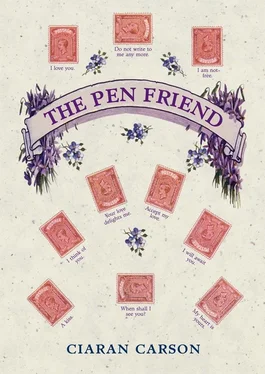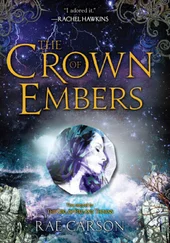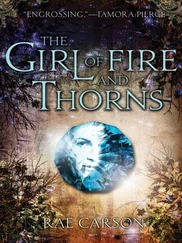Interestingly, Crawford failed to reproduce the photograph to support his verbal account, though it appeared in his posthumous book, The Psychic Structures at the Goligher Circle . In like manner, wanting to show that the sounds produced by the Circle were not the result of a collective hallucination, he hired a phonograph — an Edison Standard model — from a local dealer and, on 14th April 1916, ten days before the Easter Rising in Dublin, he successfully recorded the phenomena, which according to Crawford were produced by spiritual ‘operators’ who manipulated the psychic rods that emanated from Kathleen Goligher’s body.
I was struck not so much by this alleged proof as by the fact that the recording session took place on the same day that my father was born, and I was struck by a powerful nostalgia for a time I had never known. The Golighers were textile workers, and I imagined Belfast as it would have been then, its air trembling with noise from the linen mills which were then producing fabric for British aeroplanes in the Great War, and I indulged myself in a fancy that, since everything affects everything else, so Crawford’s phonograph had recorded not only the sound of the psychic raps but a trace, however subliminal, of the whole aural hinterland of Belfast, including the voices of its people, and that the wax cylinder contained in one of its grooves a series of infinitesimal pits and tics, a wavering scratch a fraction of a micron deep, caused by the first cry of my father as he came into the world.
I told you, Nina, how Billie Holiday’s singing affected me when I first heard it on your hi-fi system, little altered from the original recordings; and I think the hiss and crackle of old wax cylinders or shellac discs is even more atmospheric, for the dust which surrounds the music, as it drifts into the grooves, provides a more faithful molecular record of the sound in the air than is possible in a modern, hermetically sealed studio. So, when I hear Caruso’s singing — his ‘Ave Maria’ of 1914, for example, a favourite recording of my father’s — it is like dust-motes drifting through a shaft of sunlight in an empty room. The door has closed. The person has gone but the voice remains. I dreamed about my father that night, singing ‘Ave Maria’, as he used to do on Sunday evenings, sitting in the gloom of the parlour at Ophir Gardens.
A few pages later I came across a detail that once again fleetingly reminded me of my father, who happened to be born precisely one year after the death of Ludwig Zamenhof, the inventor of Esperanto. In October 1916 Crawford asked the ‘operators’ if any languages besides English were spoken in the other world they inhabited. By now it had been established that the operators were indeed entities who had once lived on this planet, but had passed on to a higher plane, this information being relayed by a system of coded raps, somewhat like Morse. After some hesitation the operators rapped out, E … S … P . Crawford could make no sense of this, beyond the speculation that the letters might stand for English, Spanish and Portuguese; the term ESP, meaning extrasensory perception, had not yet been coined. I was disappointed that Crawford had not entertained the possibility that it might be the beginning of the word Espagnol , or Esperanto ; but I thought no more about it, until, several months later, I came across an article, in the journal Esperanto Studies , that made an explicit connection between Esperanto and the Brazilian version of spiritualism known as Spiritism, or Kardecism. Allan Kardec is the pseudonym of Hippolyte Léon Denizard Rivail (1804–1869), who was born a Catholic in Lyon, but was educated in Protestant Switzerland under the famous pedagogue Pestalozzi. After completing training as a teacher, Rivail returned to France, where he taught French, mathematics and sciences at various schools. Around the years 1854–55 the ‘talking-table’ fad had swept through the salons of Europe, and Kardec, initially sceptical, began to examine the extraordinary claims made by its practitioners. He found to his satisfaction that many of the phenomena were genuine, and summarised his findings in Le Livre des Esprits (1857). He concluded that the spirit world was made of souls in various stages of enlightenment, as the living on earth are in various stages of ignorance.
Kardec’s philosophy was enthusiastically embraced in Brazil, where it was assimilated by the less educated classes into the various ‘umbanda’ sects, which recognise not only the saints of the Catholic Church, but the old Amerindian spirits, and the trickster Yoruba spirits. ‘Pure’ Kardecism seems to be mostly a middle-class phenomenon, and its followers, aware of the marginalised status of Portuguese among European languages, actively promote Esperanto as an excellent vehicle for promoting their beliefs. A key text for the Spiritists is John 10:16: ‘And other sheep I have, which are not of this fold: them also must I bring, and they shall hear my voice; and there shall be one fold, and one shepherd’, meaning, to the Spiritists, that there will be not only religious but linguistic unity when the word of God is fulfilled. For, as we read in the first verse of John, ‘In the beginning was the Word, and the word was with God, and the Word was God’; and Esperanto is a means of salvation from the curse of Babel.
In 1958 the Brazilian medium Yvonne Pereira published a novel, Memórias de um Suicida (Memoirs of a Suicide), which she claimed was dictated to her by the spirit of Camilo Castelo Branco, one of the greatest Portuguese prose writers of the nineteenth century. It is not a literary work, said Branco, but rather fulfils a sacred duty of warning against suicide by revealing the truth about the abyss that the suicide will find himself in after death; and Branco did indeed commit suicide in 1890. However, this abyss, unlike the conventional Christian hell, is not forever: one can escape it through enlightenment in the other world, and eventual reincarnation; and one of the chief instruments of enlightenment is Esperanto, which Branco learns by graduating through successive levels before enrolling in the celestial Embaixada Esperantista, the Esperanto Embassy.
Castelo Branco was only one of many spirits who made themselves known to Yvonne Pereira. In her work Devassando o Invisível (Penetrating the Invisible) she recalls that one of the ‘better dressed’ and most beautiful spirits she observed as a medium was that of Zamenhof, who appeared to her clad in his characteristic wool suit. He bore a halo of concentric waves, highlighted by a jet of brilliant green light. As I write to you, Nina, I recall the green star of my father’s Esperanto lapel badge, and I cast my eyes towards the portrait of Zamenhof which still hangs in my study where my father hung it when I was a child, opposite the crucifix. In Hoc Signo Vinces .
And you, Nina, will see the pattern in all of this. You are a Gemini. Your dual nature enables you to be a skilful gatherer and disseminator of information. You are a good communicator. You were in New York at the behest — the invitation — of the Irish Embassy, which was entertaining a group of American-Irish businessmen, some of whom were known to be financially implicated with the IRA. It was July, the marching season in Northern Ireland, when sectarian tensions rise to a predictable annual pitch, and when you suggested that I join you in New York, I was glad to get out of Belfast. By then I had as good an idea as I ever had as to what it was you did for a living. I’m a communicator, you said that first night in Eglantine Avenue, don’t you know that’s what Geminis are good at? You might call me a diplomatic aide, but I’m not. But what’s your job title? I asked. Oh, technically I’m called a Field Officer, but there are quite a few of us, and we all have different areas of expertise, you said. When I first got the job I duly reported in at nine o’clock sharp in the morning. The only person in the building was the receptionist, who was doing her nails and reading a Mills & Boon novel. The title stuck in my mind: Ask Me No Questions , it was called. Eventually some of the other staff straggled in, and by maybe eleven o’clock there were seven of us there, all of us in separate rooms. I was given a room with a desk, a chair, and a filing cabinet in it, you said, and when I was asked what I was supposed to do they looked at me with some surprise, and they said, Well, how on earth should we know? You’re the expert. That’s what we hired you for.
Читать дальше












